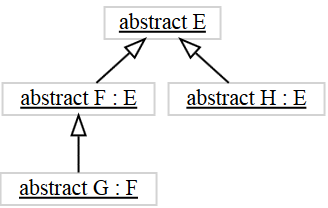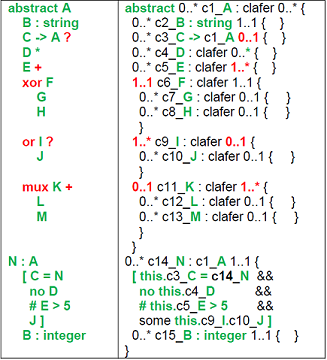Clafer a Bit More Precisely
Interpretation of Clafers, Model, and Instances
When modeling in Clafer, we are building a model which
describes model instances. A model consists of clafers,
constraints, and objectives and a model instance consists of clafer
instances and values. There are never instances in the model, only
instance specifications from which instances are produced
either manually or by an instance generator.
During modeling, we assign some interpretation to clafers and their instances.
For example, when performing feature-oriented domain analysis (FODA),
we interpret a clafer model as a feature model, clafers and
features, feature groups, and
attributes; and we interpret model instance as
a feature configuration. For more information on using
Clafer for feature modeling, see Feature Modeling using Clafer.
When modeling concepts, we can interpret clafer models as
abstractions and examples, clafers as concepts
and properties, and clafer instances as
data.
Finally, when modeling architecture, we can interpret clafers as
various architectural concepts, such as,
analysis functions, functional devices,
connectors, devices,
architectures, deployments, etc. For more
information on using Clafer for architecture modeling see Alexandr
Murashkin’s MMath
thesis.
Structure of a model in Clafer: hierarchy of clafers
Clafers and constraints form a hierarchy expressed through
indentation. Constraints are stated between square brackets:
[ and ]. Both clafers and constraints need to
be declared in a new line. We describe our terminology related to the
clafer hierarchy below.
|
A is a root, a parent of B and an ascendant of
C.B is a child of A, parent
of C, and sibling of D.C is
a child of B and descendant of A.Some constraint in the context of B.D is a
child of A and sibling of B.Some constraint in the context of A.A maximize
goal.A minimize goal.
|
Parent is a direct ascendant and child is a direct descendant. Constraints are said to be placed in context of a clafer meaning that they apply to every instance of that clafer. Constraints cannot have any descendants.
Note: The square brackets
[and]are part of the syntax of a constraint and they do not play the traditional grouping role of round-( )and curly-{ }brackets. The nesting of the opening square bracket[determines the context of the constraint. The following is an incorrect example:
|
The constraint should be declared in a new line. |
In the example below, the placement of the constraint significantly affects its meaning:
A
[ # C > 5 ]
B +
C +
[ # C > 5 ]
|
This constraint is placed in context of A meaning that there must be
there must be more than five instances of C. |
In general, every constraint can be pulled up by adding explicit quantification. The following four models are semantically equivalent; however, proper constraint nesting contributes to readability and model conciseness. In the fourth model, the constraint is pulled to top-level.
|
|
|
|
In the constraints above, this refers to an instance of
the context clafer of the constraint. That is, in model #2,
this refers to an instance of B, in #3, an
instance of A, and in #4, this is not used because the
constraint is top-level.
For convenience, a single constraint can be written in multiple lines and it means the conjunction of the constraints from each line. The following three models are equivalent:
|
|
|
Inheritance hierarchy
Unlike the nesting hierarchy of clafers, the inheritance hierarchy is not directly visible in the model. We describe our terminology related to the inheritance hierarchy below.
abstract E
abstract F : E
abstract G : F
abstract H : E
|
E is a root type, a direct super type of F and
a super type of G.F is a direct subtype
of E, a direct super type of G, and sibling
type of H.G is a direct subtype of
B and subtype of E.H is a
direct subtype of E and sibling type of F. |
Any clafer can have at most one direct super clafer.
We provide a graphical visualization of the inheritance hierarchy:

Meaning of a model
Any clafer can be thought of as a form that describes many instances. Constraints restrict the set of instances described by a given clafer. Sometimes, a clafer becomes so restricted that it describes a set of isomorphic instances.
Important note for programmers: Clafer is a declarative language and a clafer model is a declarative specification. There are no classes, fields, attributes, objects, assignments, references, nulls in Clafer. An abstract clafer declaration defines a new type. A concrete declaration additionally defines a relationship between the clafer and its parent, a set of instances of the clafer and instances of all of its descendant clafers. In our example, the model about a
Personcontains a clafer declaration in each line.
abstract Person
Name -> string
xor Gender
Male
Female
Married ?
Address
Street -> string
UnitNo -> integer ?
JohnDoe : Person
[ Name = "John" ]
[ Male ]
[ Married ]
[ Street = "12 Main St." ]
[ UnitNo = 3 ]
|
An abstract clafer called
A concrete clafer called Male and Married, that is, JohnDoe can be
characterized as a Married Male.
|
In general, to declare a new clafer, simply state its name and indent it appropriately with respect to some other clafer. Clafers that are not indented are the root clafers (or top-level clafers).
Declarations of clafers can additionally be extended with:
- Type, that is, a kind of value a given clafer can
point to:
string,integer, or any other clafer, e.g.,
Name -> string
Country -> NorthAmericanCountryNote: Reference clafers can only point to root (top-level) clafers. This restriction is relaxed in the upcoming Clafer 0.4.0 which implements redefinition.
- Clafer cardinality, that is, how many instances of
a given clafer can appear as children of the parent clafer:
?(optional = 0 or 1 instance), nothing (default) (mandatory = exactly one instance),*(multiple optional = any number of instances),+(multiple mandatory = at least one instance),m..n(minimummand maximumninstances), andn(exactlyninstances), e.g.,
UnitNo -> integer ? City -> string child -> Person * participants -> Person + hand 2 doors 3..5 flavour 2..* LochnessMonster 0 |
optional clafer “at most one” mandatory clafer (by default) “exactly one” multiple optional clafer “zero or more” multiple mandatory clafer “at least one” multiple mandatory clafer “exactly 2” multiple clafer, “at least 3 and at most 5” multiple clafer, “at least 2” prohibited clafer, “zero” |
- Group cardinality, that is, how many of the
children of a given clafer can be instantiated:
any(no restriction – any number, same as0..*),xor(exactly one of the children clafers, same as1..1),or(at least one of the children clafers or more, same as1..*),mux(at most one of the children clafers, same as0..1), andm..n(at leastm, at mostnof the children clafers), e.g.,
|
(the default group cardinality is any:
0..*)(children of group “any” are by default mandatory) (see clafer cardinality) (any group: 0..*)(children of group any are by
default mandatory)(or group at least one of:
1..*)(xor group exactly one of: 1..1)(mux group at most one of: 0..1)( at least 2 and at most 3 of group:
2..3) |
Important! Clafers grouped under a clafer with group cardinality other than
any(0..*) by default have optional clafer cardinality. E.g.,Male,Married,Ms, andStrawberryare optional. Children ofAddressandAddress2, however, have the default clafer cardinality – mandatory (1).
- Direct super clafer. Clafers can inherit children of other clafers, e.g.,
|
(JohnDoe is an instance specification of (example of) Person) (Person is a direct super clafer of Student) |
In both examples above, Person is a direct super clafer.
Only root (top-level) clafers can be direct super clafers (This
restriction is lifted in Clafer 0.4.0 which supports both references to
and inheritance from nested clafers).
- Abstract or concrete. Abstract clafers represent forms based on which concrete clafers can be constructed. However, abstract clafers do not directly represent a set of instances. Concrete clafers represent sets of instances, with cardinality of that sets being the same as the cardinality of the clafer. Only concrete clafers can be referenced (pointed to by other clafers) within the constraints, e.g.,
|
(abstract clafer (form)) (concrete clafer (an example)) (concrete clafer (an example) - a set of 10 instances of Person) |
The difference between
: and ->
Both : and -> are different means of
defining subsets. Colon : defines a partitioning, that is,
a division of a set into disjoint and covering subsets; whereas,
reference -> defines an arbitrary subset of instances of
the given cardinality, potentially overlapping with existing partitions.
For example,
abstract Person
Alice : Person
Bob : Person
Member : Person 5defines a partitioning of the set Person into 7 disjoint
and covering subsets (Alice and Bob are
singletons and Member has 5 elements). However,
pair -> Person 2defines an arbitrary subset of the set Person of
cardinality 2. Example instances of pair include
pair = Alice, Bob
pair = Alice, Member1
pair = Member2, Member5Desugaring
So far, we have been using the “concise” Clafer notation that leverages many convenient defaults. The Clafer translator can output a fully resolved “desugared” model in full Clafer syntax. The desugared model is useful for learning what the different defaults are expanded to.
Usage: Invoking the translator as follows
clafer –m=clafer <model_name.cfr>will produce a new file model_name.des.cfr.
Both the concise and the desugared versions of the person model used
throughout this tutorial are available: person.cfr and
person.des.cfr. Here let’s look at the desugaring of a
contrived example. Fragments in green and bold are the same in both
models. Fragments in red and bold on the left are expanded into
corresponding fragments on the right. Fragments in black on the right
are results of applying defaults, resolving indentation, and making the
identifiers unique.

In the desugared model, the following changes were made:
- Names were mangled to be unique (note that a new clafer
Bis declared as a child ofNand it’s unique name is different from the claferBdeclared as a child ofA) - Indentation was resolved into explicit nesting using curly brackets
{ } - Clafer and group cardinalities were specified explicitly
- The default super clafer
claferwas added - The multi-line constraint was rewritten into an explicit conjunction
- The default qualifier
somewas added in the last constraint
The distinction between the concise and desugared syntaxes is not
strict – modelers may choose the level of detail that is most suitable
for their purpose. For example, explicit nesting using { }
may be freely mixed with indentation. Also, modelers may choose
different styles of specifying cardinality, for example, one may
interchangeably use 0, 1, 1..1,
?, 0..1, +, 1..*,
*, 0..1, etc.
Back Introduction

